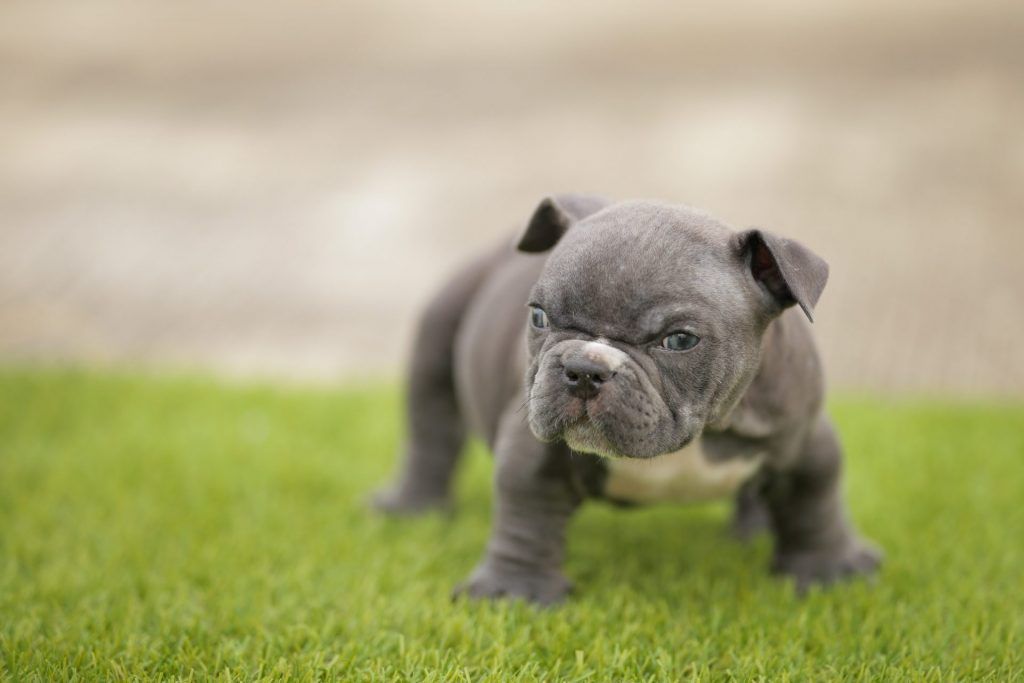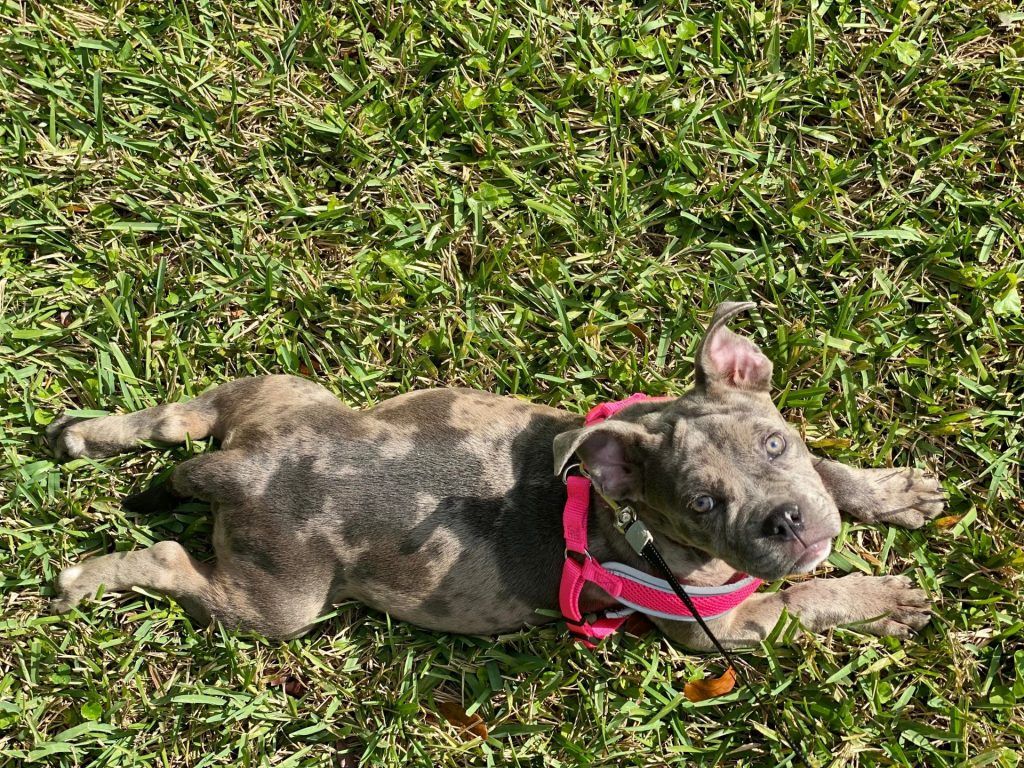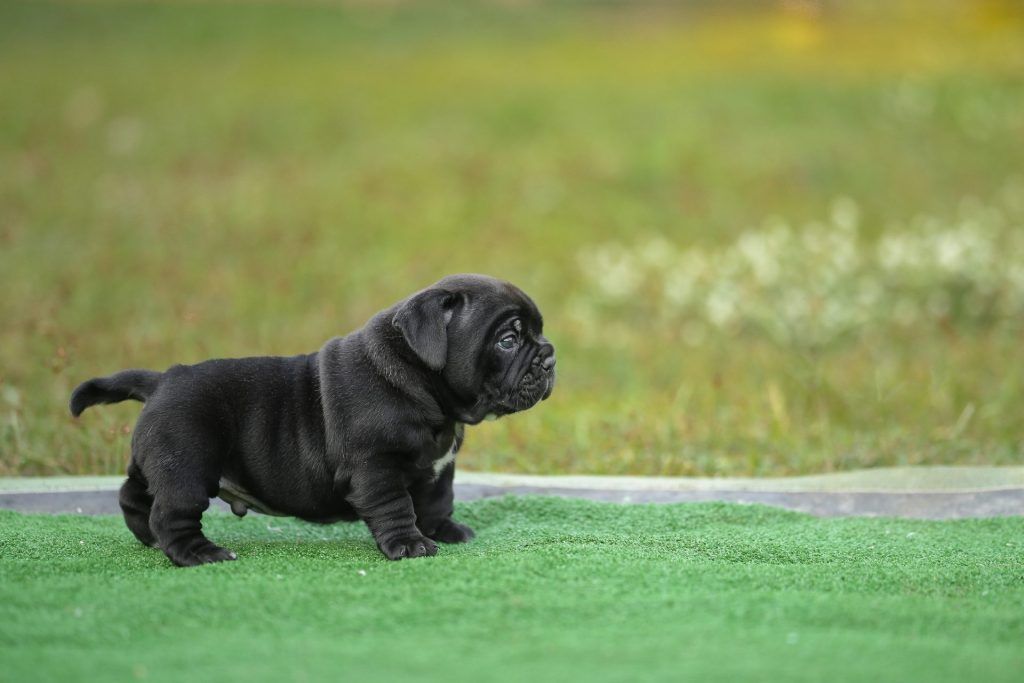The exotic bully is a newer dog breed, first bred in 2008. This new bully breed, also called an American bully exotic, quickly gained popularity among dog lovers, becoming something of an overnight sensation. Despite the rise in popularity, exotic bully breeders also managed to create controversy and pit people in the bully community against each other with this new breed.
Exotic bullies are a not-so-distant cousin of the American bully, bred primarily for their appearance. A smaller, more compact dog with exaggerated features. Which is where the disagreement comes from. On one side of the fence, there are those who believe the exotic bully is an unhealthy representation of what the American bully is supposed to be. The other side is full of people who love the new version regardless of the potential health impacts.
The split has become so deep that there have been online attacks and even physical fights between both sides of the exotic bully controversy.
With no agreed-upon breed standard, it’s possible that some breeders will continue with reckless abandon in pursuit of the “perfect look”, which will only fuel the controversy. Fortunately, another group has emerged promoting what they call a clean exotic bully, a version of the breed that retains the exotic look but keeps health concerns for the dog in mind.
What is an Exotic Bully?

Initial crosses between the American bully and other bully breeds almost certainly happened prior, but 2008 marks the real point when the exotic bully came to be.
The exotic bully was created to be a shorter, more compact version of the American bully but with more bulldog genes in the mix. The result was a short, muscular dog with a wide chest, thick bone structure, and a shorter muzzle. Some of the exotic bullies’ features are heavily exaggerated as well, like their short legs with huge muscles and large heads covered in wrinkles.
Since the exotic bully is a relatively new breed, they are not recognized by the American Kennel Club (AKC), the American Bully Kennel Club (ABKC), or any of the other major dog organizations. But some registries have started recognizing the exotic bully as its own breed. At the time of writing, the registries I found that recognize the exotic bully are:
- World Dog Federation (WDF)
- The US Bully Registry (USBR)
- International Bully Coalition (IBC)
- American Bully Registry (ABR)
- International Bully Register (IBR)
It’s worth noting that the IBR recognizes this breed of dog, but they say the bully exotic is an extension of the American bully instead of a separate breed.
Breed Standards
Each of the registries above has approved its own set of breed standards for the exotic bully. They are in agreement on some points but quite different on others.
Common faults and disqualifications are:
- Albino or merle colors
- Cryptorchidism (undescended testicles)
- Short or Kinked tails
- Feet pointing outwards (easty-westy feet)
Since a breed standard has not been agreed on, at this point, the “ideal” appearance of an exotic bully dog varies depending on who you talk to. What we found as a general guide is:
- Short in stature.
- Similar in appearance to the American bully but with bulldog characteristics.
- Features should be exaggerated.
As you can see, there isn’t much to go on for this new breed just yet. Most of the registries claim the breed standard is subject to change as the breed evolves.

Photo Credit: Shutterstock
The Exotic Bully and the Clean Exotic Bully
Like I mentioned above, the clean exotic is a type of exotic bully that aims to eliminate health issues and exaggerations from the breed. The clean exotic is not a separate breed, but rather a breeding standard that some exotic bully breeders follow to produce healthier and more balanced dogs.
The clean exotic is different from the standard exotic in terms of appearance, temperament, and health. The clean exotic has a more moderate and proportional body, with less extreme features, such as a longer muzzle, a smaller head, and a higher stature. The clean exotic also has a more stable and calm temperament, with less aggression and hyperactivity. The clean exotic also has fewer health problems, such as breathing difficulties, joint issues, skin allergies, and eye problems.
The clean exotic is not recognized by any major dog organization, but it is supported by some bully registries, such as the International Bully Coalition (IBC) and the U.S. Bully Registry (USBR). These registries have established breed standards for the clean exotic, which define its ideal physical traits and temperament.
The clean exotic is a type of exotic bully that appeals to those who love the exotic bully but want to avoid its health and ethical issues. The clean exotic is a more responsible and respectable way of breeding exotic bullies that can improve the quality and longevity of the breed.
What are the Characteristics of an Exotic Bully?
If we get away from breed standards and focus on what typical exotic bullies look like we get some more information. The exotic bully is split into 2 categories: the standard exotic, also called extreme exotic, and micro exotic.
Size
Standard exotics should be under 18″ in height and between 50-90 pounds. Weight and height should be proportionate.
Micro exotic bullies should be under 13″ in height and between 25-40 pounds. Again, weight and height should be proportionate.
coat
For either type, the coat should be short, smooth, and glossy. It can come in any color or pattern.
Appearance
The general impression is that of a powerful and muscular dog with a compact body and a confident attitude. The head of an exotic bully is large and broad, with a flat skull and a short muzzle. The eyes are round and set apart and can be any color except blue. The ears are small and can be cropped or natural. The nose is large and wide and can be any color except pink or red.
The neck of an exotic bully is thick and strong, with a slight arch. The chest is wide and deep, with well-sprung ribs. The back is short and straight, with a slight slope from the withers to the rump. The tail is short and straight or slightly curved. It should not be docked or kinked.
The legs of an exotic bully are short and sturdy, with thick bones and well-defined muscles. The front legs are set wide apart and slightly bowed. The hind legs are set well apart and slightly angled. The feet are round and compact, with well-arched toes and short nails.
Personality
The exotic bully should be sociable and friendly toward people, especially children. They should show loyalty to their family and be neither aggressive nor timid. They should get along well with people and other animals, as well as display intelligence and an eagerness to please their owners. They can be stubborn and independent and will need consistent training.
There is no denying that the exotic bully breed has an aggressive look, but they would rather curl up on the couch and cuddle than fight.

Photo Credit: Shutterstock
Interesting Facts About the Exotic Bully
The exotic bully is a fascinating breed that has a lot of unique features and qualities. Here are some interesting facts about the exotic bully that you may not know:
- The exotic bully is not a purebred dog but rather a hybrid of various breeds, such as the American Bully, the French Bulldog, the English Bulldog, the Shorty Bull, and the Olde English Bulldogge.
- The exotic bully has four different types: the micro exotic, the pocket exotic, the standard exotic, and the clean exotic. The clean exotic is a type that aims to eliminate health issues and exaggerations from the breed. Many consider the pocket bully exotic and the micro to be the same thing.
- There are over 20 coat colors the exotic bully can have. Two of them, albino and merle, are considered undesirable.
- They are a pricey breed, some costing as much as $30,000.
What are the Health Issues of an Exotic Bully?
The exotic bully is a breed that suffers from many health problems due to its genetic makeup and physical characteristics. Some of the most common health issues of an exotic bully are:
- Brachycephalic Obstructive Airway Syndrome (BOAS)
- Hip Dysplasia
- Elbow Dysplasia
- Skin Allergies
- Eye Problems (cherry eye, progressive retinal atrophy, cataracts)
- Hypothyroidism
- Congenital Heart Failure
- Cerebellar Abiotrophy
Other common health concerns include:
- Demodectic Mange Atopy
- Ichthyosis
- Luxating Patella
- Eczema
How to Find and Buy Exotic Bully Puppies for Sale?
Exotic bully puppies are still considered rare and only bred by a handful of breeders, but they aren’t typically hard to find. You may have to sit on a waitlist for a while, and the hard part is often the price. Healthy exotic bully puppies range in price from $2,500 to $5,000 but can go up to $30,000, depending on breeding, color, disposition, and other factors. If you are serious about getting one, you can check out your local dog shows and meet breeders or look on social media. Do your due diligence when picking a breeder to avoid those breeding without health in mind.
How to Care for an Exotic Bully?

Photo Credit: Shutterstock
Exotic bullies are fairly low-maintenance dogs. They have a few special needs because of their health concerns, but nothing too out of the ordinary.
Diet and Nutrition
Compared to other breeds, exotic bullies easily become fat or obese if they are overfed. They don’t have any specific dietary needs. Feeding them high-quality food without overfeeding will keep them happy and healthy.
Grooming
Exotics have a short, smooth coat that doesn’t shed much. Brushing them once a week will help remove any dirt or loose hair and keep them clean.
Exercise
Exotic bullies are not high-activity level dogs. They need some exercise but no more than 30 minutes a day. They can easily develop breathing problems or heatstroke if they overexert themselves or are in extremely hot or cold temperatures for long.
Training
Exotic bullies are intelligent, stubborn, independent, and often eager to please their owners. They need firm and consistent training from an early age to establish yourself as the leader and teach them good behavior and manners. Use positive reinforcement methods and, above all else, be patient. Harsh training or physical punishment will quickly make one of these dogs fearful instead of respectful.

























